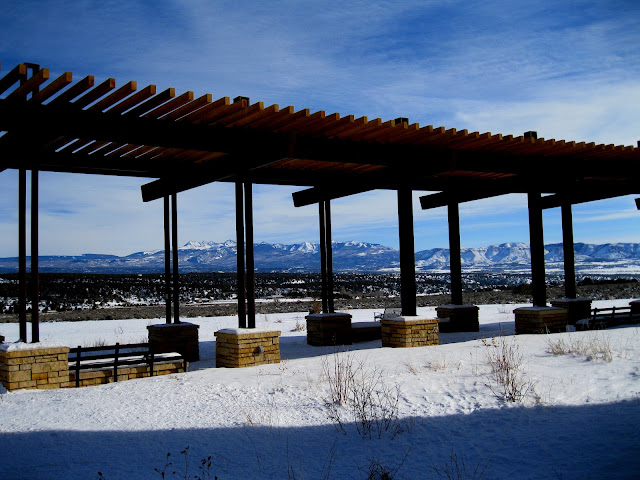The Tracks Hike explored the mountain shrub environment of the 7800 feet elevation Morefield Canyon Campground area. As part of the Mesa Verde effort to attract more winter visitors, 4.8 miles of groomed snow trails have been prepared in the Morefield Campground area.
Other areas of Mesa Verde also have groomed winter trails and the Mesa Verde web site has maps and up to date information on the conditions of these trails. There has been more snow in the 2013 winter than relatively light 2012. (Use the “snowshoe hikes” label to find these other trails.)
Mesa Verde National Park received a grant of $9765 from the Active Trails Program of the National Parks Foundation in 2012 to develop winter snow shoe and ski trails. Part of the funding was used to purchase snow shoes that are available for free loan to anyone interested in winter hiking at the park. They are available at the new Visitor Center and the Chapin Mesa Museum.
The first part of the hike included an introduction to animal tracks and emphasized Gestalt Tracking. Gestalt is a German word for form or shape. It is used in English to refer to a concept of wholeness.
Individual animal tracks in snow might be hard to identify, but the using of the gestalt approach considers the animals range and habitat for the season, where to the tracks come and go from, what line does it follow (zig zag?). Also consider the size and shape, number of toes, claws, stride and straddle, gait pattern, and other signs like scat and smells. (in the 2012 Winter Ecology Hike there is more information on these details.)
The Morefield Campground area is dominated by Gambel Oak (Quercus gambelii), while most of Mesa Verde is Pinon and Juniper forest. At one trail stop there was a short discussion of the purplish Colorado Hairstreak Butterfly, (Hypaurotis crysalus) the state butterfly of Colorado since 1996. This choice was due to the steady lobbying of 4th graders from Wheeling Elementary in Aurora, Colorado (led by teacher Melinda Terry).
This butterfly species depends upon the Gambel oak which is both the favorite roost of adults and usual food source for caterpillars. Eggs are laid singly in late summer on twigs of Gambel oaks or another oak species. The caterpillars emerge in the spring and eat young leaves. Adults feed on tree sap and probably honeydew secreted by other insects rather than on flowers. The species has one flight, usually from mid-June to August.
The winter ecology brochure available at the trail head also has a paragraph on observing insect formed galls on trees and shrubs but doesn't mention any specific insects.
There was also a demonstration of the use of motion activated cameras for the purpose of studying wildlife. Some of the current use of these cameras at Mesa Verde is to study the interaction of feral horses with the native deer and elk. There is a current project in the park concerning what to do about the 100-150 feral horses that range through the park and are trampling some of the remote archaeology sites.
The most common tracks that we saw were coyote and cottontail rabbits. Here, we’re looking at some smaller stride and straddle canine tracks that could be from a fox.
We also saw tracks that we thought could have been a bobcat, and some that might have been a weasel. We didn't see any mule deer tracks as they prefer to move down to less snowy conditions. We spent about 3:00 hours on the entire hike but only covered about 1 mile in slow walking with frequent stops. It was a perfect sunny 25 F degree mid February morning and there were about 16 hikers in the group.
The Visitor Center bookstore has a simple pocket field guide to animal tracks available for $5.95. This guide is for all of North America so the user will have to apply the gestalt principle to use it effectively at Mesa Verde.
Mesa Verde Winter Festival 2013
The first annual Mesa Verde Winter Fun Festival was held on February 23, 2013 in the Morefield Campground area. A main event three-mile fun cross country ski race was held on the Meadow Bliss Trail at 11:00 AM.
During and after the race there was a hands-on primitive skills demonstration including bow and drill fire starting, atlatl usage and yucca cord making. The fire starting demonstration was actually successful. The bow spun the yucca stalk drill on a piece of soft wood and produced smoke and a small coal. Using some easily combustible plant material that looked like Juniper bark, blowing on the coal produced a flame.
The atlatl was a device that increased the leverage for throwing spears or arrows. There was a supply of arrows on hand and a small target range was set up. It takes some practice to get the hang of throwing.
It was a good day for snow shoe hiking on the Morefield Campground Trails. One of the options includes a flagged route from the parking area to the trail head of the Point Lookout Trail. This route cuts across the north side of the campground loops and includes some segments through the groves of Gambel Oak.
Part of this route passes through the amphitheater area. Although this isn't a long distance, it takes extra effort to push through the ungroomed snow. In the evening, there was a planned opportunity for skiing or snow shoeing by the full moon.






































